| ICE Case Studies
|
Belize-Reef: The Effect of Democracy, Development, Disputed Borders and Climate Change on the Mesoamerican Reef Marc Cardwell |
I.
Case Background |
Belize is a poor country with a weak but functioning democracy. The Mesoamerican reef and its associated watershed supports tourism and fishing, which along with agriculture, are the primary sources of jobs and income. All the principal political organizations in Belize are committed to raising the standard of living, and support the continued growth of tourism as well as other job creating initiatives. The reef is already threatened by degradation in water quality due to increased human activity. Climate change will further reduce the carrying capacity of the reef at precisely the time that population growth and rising expectations will create demand for more rapid development. Efforts to ensure a coherent approach to development and the long term sustainability of the Mesoamerican reef are further complicated by the fact that Belize, Guatemala, Honduras and Mexico all claim soverignty over significant portions of the reef. A long term border dispute with Guatemala hampers cooperation on protecting the reef and the western portion of the watershed. While the current level of conflict is low, any dramatic decline in the health of the reef will put enormous strains on civil society in Belize and cold lead toincreased conflict in the region.
The Mesoamerican coral reef is almost 700 miles in length and is the world's second longest barrier reef. The reef begins off the coast of southern Mexico, stretches the entire length of Belize and extends into the territorial waters of Guatemala and Honduras. The reef is home to more than 65 species of coral and over 500 species of fish and more than 2 million people live along the coast bordering the reef. The potential for conflict arises from development decisions and population growth that threatens to overwhelm the carrying capacity of the Mesoamerican reef. This is especially true for Belize, where the three primary industries are tourism, fishing and agriculture. Like any coral reef, the Mesoamerican reef is potentially at significant risk from even a two- or three-degree change in the annual temperature. Changes in seawater chemistry that are predicted to accompany climate change are also of concern. The outlook for Belize would be negatively impacted by any degradation in the health of the reef. (World Wildlife Fund, 2011: Mesoamerican reef)
Belize Background
Belize is part of Central America; however the politically
dominant population is of African descent and culturally Belize has
more in common with the islands of the Caribbean than it does with its
Spanish speaking neighbors. Belize has an estimated population of
321,115 and a GDP of $ 2.651 billion (2010 estimate). Four out of ten
citizens live in poverty and the average age of the population is 21.
The need to increase the number of jobs and the incomes of its citizens
places enormous pressure on the democratically elected Government of
Belize (GoB) to step up the exploitation of the reef. Incomes have
risen along the coast and there is a predicable link between economic
growth along the coasts and an expected rise in population. Population
growth (estimated at 2.056% ) will place increased pressure on the GoB
to increase the exploitation of the reef (by development, fishing and
increasingly, aquaculture) at the very time that climate change will be
negatively impacting the health and resilience of the reef ecosystem.
(CIA Factbook, 2011: Belize.)
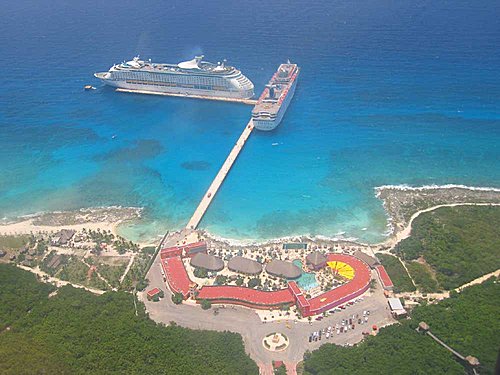
The government of Belize has made an effort to towards sustainable development. Unfortunately, the governments of Guatemala and Honduras are realtively weak and enen the few existing environmental regualtions are rarely enforced. This patchwork approach to managing development bodes ill for the long term health of the reef.
The photo at left, while taken slightly north of Belizean waters, highlights both the beauty of the reef environment and the threat posed by increased tourism. While the reef provides important benefits to all four countries, Belize is especially dependent upon the health of the Mesoamerican reef because tourism and marine products are the two most important sectors of its economy. (World Wildlife Fund, Mesoamerican Reef, 2011)
Photo source: Colorful CostaMaya: http://www.ssqq.com/travel/rhapsody200604.htm.
Ongoing
Central America.
Caribbean
Belize and the Atlantic coasts of southern Mexico, Guatemala and northern Honduras.
Sovereign Actors: The governments of Belize, Guatemala, Honduras and Mexico.
Other actors: International investors in tourism, petroleum exploration, and aquaculture. Local political parties and international NGOs advocating for conservation also have a significant stake in development decisions.
(i) Many.
The Mesoamerican reef is currently threatened by deforestation (leading to a decline in water quality), pollution and overfishing.
The Mesoamerican reef is a critical economic engine for Belize, Guatemala and Honduras. The three primary industries of Belize are tourism, fishing and agriculture. All three would be negatively impacted by any degradation in the health of the reef. (CIA Factbood, 2011: Belize)
Tropical. Ocean. Coral reef and associated watershed..
The map below shows the Mesoamerican marine reef and its associated watershed:
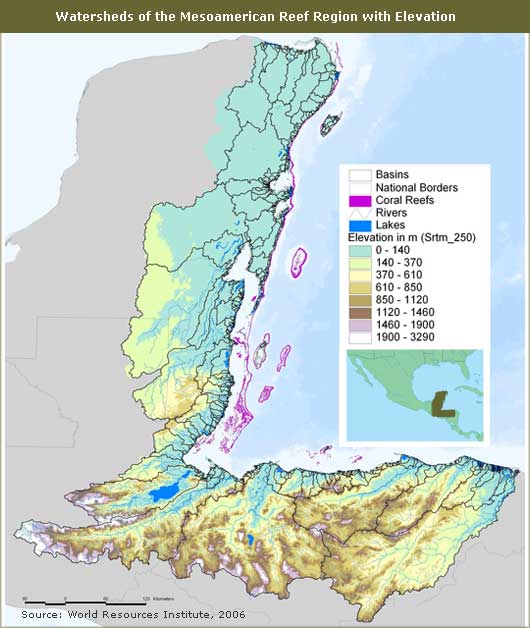
Source: World Resource Institute; map of mesoamerican reef and watershed; http://archive.wri.org/image.cfm?id=2684
A. Act: Atlantic Coasts of southern Mexico, Belize, Guatemala and Honduras.
B. Harm: Same.
The reef is threatened by many types of development and exploitation. As can be seen in the map above, the water quality of the reef is susceptible to contaminated runoff from a large area. Causes of contaminated runoff include agricultural development. deforestation and municipal waste. Tourism is both a growing source of jobs and income and, potentially, a massive threat to the health of the reef because of the development of new hotels and the related real estate boom. Both Belize and Guatemala have begun to develop their limited but significant oil reserves and extracting, storing and shipping oil certainly increases the opportunity for environmental accidents. For additional information on how proposals for off shore oil drilling could threaten the Mesoamerican reef, see Conference on off-shore oil exploration.
Civil.
There is ongoing conflict between the finite carrying capacity of the reef and the pressures expanding populations will place upon the reef. These pressures will be exacerbated by climate change, since even a two or three degree rise in temperature could substantially reduce the ability of the reef to support fishing and tourism. ("Coral reefs and Global Climate Change." Robert W. Buddemeier, Joan A. Kleypas, and Richard B. Aronson; 2004: P.5) On the waters around the reef most of the ongoing conflict is between the Government of Belize and foreign fishermen. On land, most of the current conflict is between the Government of Belize and illegal loggers, many of whom operate out of Guatemala. Within Belize there is increasing potential for conflict between local communities and large scale development. These conflicts pit traditional lifestyles against new opportunities for jobs and income. These conflicts are often fueled by money from outside investors and have the potential to put enormous strains on a poor and fragile democracy even if the ultimate result is a policy that advances sustainable development. A far less desireable alternative future is unsustainable development that produces short turn returns but degrades the reef. Given the significance of the reef and the potential value of reef related developments, it is possible to imagine a negative spiral of unsustainable development where the pressure for jobs leads to series of decisions that, considered individually, lead to a short term increase in employment and income but which, when considered in the aggregate, undermine the ability of the reef to support tourism and fishing. ( Perez, A., Chin-T, C. and Afero, F. 2009: passim.)
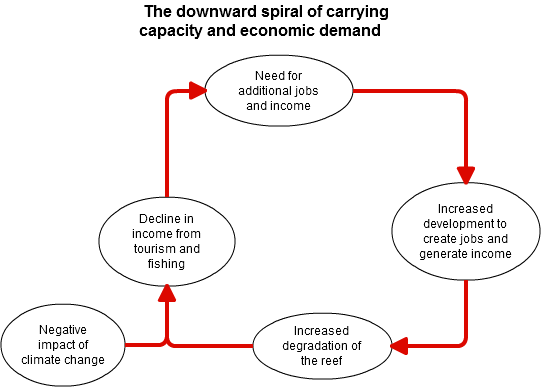
The long term outlook for Belize is further threatened by three additional factors. The first is Guatemala€™s continued claim over the territory of Belize, a fact which does little to encourage Guatemala to respect Belize€™s Economic Exclusion Zone. The second is increasing spillover of drug violence from Mexico and Guatemala into Belize. The third factor is that, like the majority of the coastal population of Belize, the communities on the Atlantic coasts in Guatemala and Honduras are predominantly of African descent, and have been routinely discriminated against by their own central governments. This historical reality encourages the central governments of Guatemala and Honduras to focus on the reef as an opportunity for investment rather than as an essential resource that needs to be protected to sustain healthy local communities.
The primary significance of climate change is that th projected climate change will lead to a gradually reduced carrying capacity for the reef and the watershed at precisely the same time that political pressures will encourage decisionmakers to view the carrying capacity in the most optimistic manner possible.
Low.
Low.
The ecosystem of any coral reef is sensitive to environmental change.
The Mesoamerican coral reef is extremely vulnerable to increased
development (due to degradation of water quality) and to climate
change. The implications of even moderate climate change is especially
complex: a coral reef can be negatively impacted by changes in water
temperature, increases in the water level and/or changes in water
chemistrye.g. increased levels of atmospheric CO2). The IPCC predicts
that the region may see a 2-3degree C. increase in average temperature
by 2050. Just as significant, precipitation may drop by 10-20 percent,
which would negatively impact the water chemistry of the reef ecosystem.
(IPCC,2007: 11.9.3.1 Caribbean)
Even absent the expected impacts of climate change the Mesoamerican reef
is already being degraded by what could be described as €œroutine€
development. The coastal economy is dominated by the rapid growth of
tourism and fishing. The watershed economy is dominated by logging and
agriculture, with oil production becoming an issue of increased
importance and economic concern. Regulations, such as they exist, are
often ignored. Large portions of the watershed are virtually
ungoverned.
Internal Sources of Conflict
The fact Belize is a democracy and that the major parties are committed to improving the standard of living of the entire population presents an additional challenge to sustainable development and conservation. In a democracy political parties win elections by delivering goods and services. The political imperative to create jobs for a growing population will tend to frame the debate as being between €œprotecting scenery€ (conservation) and "creating jobs" (development). Any leader who wants to be re-elected will be under pressure to support development because development produces jobs and increases income. This pro-development pressure comes from a combination of the short term interests of the electorate and the long term interests of investors. Unfortunately, both groups will have every incentive to minimize the risk of any single specific development project to the health of the reef.
Local skepticism towards conservation laws is a common problem, especially when conservation can be portrayed as an attempt by outsiders (e.g. Western governments and International conservation organizations) to limit the economic opportunities available to the local population. This phenomenon has been observed across time and cultures: in Bolivia indigenous people opposed the creation of bio-reserves just as in the United States local ranchers and businessmen opposed the creation of Yellowstone national park and continue to chafe at Federal interference as to what they can do with €œtheir land.€ In a few cases an autocrat has been able to force conservation upon an unwilling body politic (examples include Theodore Roosevelt€™s executive actions to create the U. S. National Park System and actions by the dictator Rafael Trujillo to protect the forests in the Dominican Republic). In other instances grass roots political action has led to a long term political consensus about the importance of conservation and sustainable development (e.g Costa Rica). One of the recurring challenges for conservationists has been convincing local stakeholders that the risks of development equal or exceed the benefits. Political action in support of sustainable development requires the risks be both tangible (a threat to local culture and/or health) and credible (the data is clear and the public believes the information).
The following diagram illustrates the ways that key stakeholders influence a development decision. Note that for local communities to have any significant influence they must have two things: the first is political influence (i.e. they need to be seen as stakeholders) and the second is an internal consensus about the level of risk posed by the proposed development action.
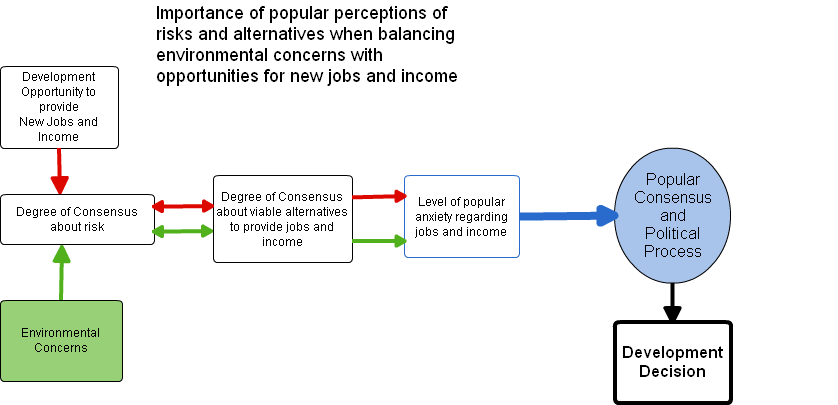
Bottom Line: Doubt about the long term risk enables leaders and voters to rationalize a decision to focus on short term benefits. Politicians will be tempted to use doubt as a way to justify development that has the potential to win votes. If conservation requires a consensus about the risk posed by development then it follows that a goal of pro development forces is to highlight the benefits and downplay -- and create doubt about -- the risks. The supporters of aggressive development have the advantage of being able to talk about specific short term economic benefits (jobs, income, etc) from any given project while the supporters of conservation are often attempting to focus stakeholders (who may well need jobs now) on long term risks. Unfortunately, any government committed to reducing poverty is going to be under enormous pressure to minimize the risks posed by any specific project that promises jobs and economic development.
There are two potential paths that could lead to domestic political conflict: the first is that tourists come to Belize precisely to experience a healthy reef and at some point a combination of development and climate change might degrade the reef and destroy the very experience that has lead to the growth of tourism. Any decline in the number of jobs created by tourism would create enormous pressure to expand other forms of job creation. Unfortunately, for Belize, the same degradation of the reef that might lead to a decline in tourism would likely lead to a contemporaneous decline in fish catch. A decline in Belize€™s two most important economic sectors would put enormous pressure on Belize€™s relatively weak government.
External Sources of Conflict
The challenge of controlling domestic pressure for development within Belize is further complicated by two additional factors. The first factor is Guatemala€™s continued claim to all of the national territory of Belize, a claim that makes it difficult for the two countries to cooperate even when there would be mutual benefit in such cooperation. The Guatemalan claim dates back to the 1600s and a dispute between Spain and Great Britain. Many historians have concluded that Guatemala has a legitimate legal claim; however, Belize remains a member of the British Commonwealth and Great Britain continues to station a small but significant garrison of troops in Belize to deter Guatemalan military action. Actual conflict has been rare; however, in 2000 a Belizean patrol shot a Guatemalan citizen along the disputed border. There have been various efforts to negotiate a long term agreement witout success and the issue is routinely exploited by politicians in both countries. As a result, cooperation between Belize and Guatemala is fitful at best. Farmers and loggers have routinely ignored the long jungle border between Belize and Guatemala. More recently, drug traffickers have moved their operations from Mexico into the jungle areas on both sides of the border. This criminal activity has served to exacerbate the lawless nature of the region and the chemicals required for drug processing have severe, albeit localized, environmental impacts. (wikipedia: Belizean-Guatemalan_territorial_dispute, 2010) (Nick Mirkoff, 2011: P.1)\
Belize and Guatemala claim many of the same waters as part of their respective Exclusive Economic Zones (EEZs). There have been fairly frequent incidents of conflict between fishing boats in areas claimed by both countries. In addition to fishing, there are other potential categories of conflict. For example, each year Guatemala ships more than one million tons of oil through waters adjacent to the mesoamerican reef. A significant oil spill in this area would be devastating to both fishing and tourism. While Honduras also claims some of the same waters as part of its EEZ the most significant threat may come from Honduras€™ embrace of intensive aquaculture. Shrimp farming in Honduras has led to the destruction of more than 20,000 acres of mangrove swamp and a significant degradation in water quality. (Diego Cevellos, 2011: P 1.)
| Belize EEZ | Guatemala EEZ | |
|---|---|---|
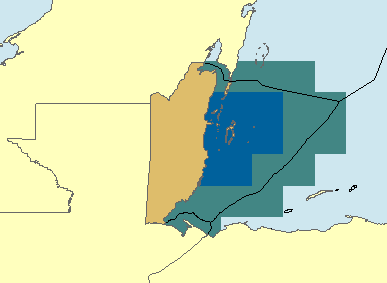 |
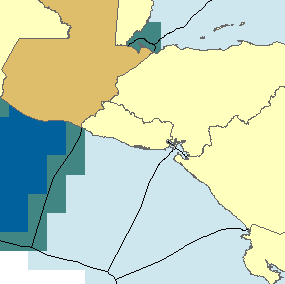 |
Belize EEZ shows Atlantic coast areas on right. Guatemala borders Belize to the West and the North. Guatemala EEZ shows Atlantic coast on right and Pacific coast on left. |
EEZ Legend

Maps used by permission of The Sea Around Us.
Another source of potential conflict may be the most interesting of all, and could have long term implications for Belize and the entire Atlantic coast of Central America. Just as is the case with the coastal population of Belize, the Atlantic coast populations in Guatemala and Honduras are predominantly of African descent, and have been historically discriminated against by the Spanish speaking majorities of those countries. It is impossible to predict how these racial, cultural and economic issues might play out in the face of a sustained economic downturn exacerbated by climate change. The table below underscores the racial differences between the coastal commuities and the majority populations. The table also highlights the fact that the African descendents who dominate the Government of Belize are actually a minority of the population. (Wikipedia: Afro Latin American, 2011:website.)
| Country | Percentage of Population of African Descent | Estimated Number of African Decendants |
|---|---|---|
| Belize | 30% |
110,000 |
| Guatemala | >2 % |
+200,000 |
| Honduras | 2.0% |
+150,000 |
13. Level of Strategic Interest
Low. The only way that Belize could become of significant interest is if a deteriorating situation in Belize began to impact the stability of Mexico.
Ongoing. The territorial dispute between Belize and Guatemala is
ongoing and unlikely to be resolved anytime soon. The disputes within
Belize about the proper balance between development and conservation are
ongoing and likely to intensify.
1. World Wildlife Fund; http://www.worldwildlife.org/what/wherewework/mesoamericanreef/index.html; accessed 11/25/2011.
2. CIA Factbook, Belize; https://www.cia.gov/library/publications/the-world-factbook/geos/bh.html; accessed 11/25/2011.
3. "Coral reefs and Global Climate Change." Prepared for the Pew Center on Global Climate Change. Robert W. Buddemeier, Joan A. Kleypas, and Richard B. Aronson; http://www.pewclimate.org/docUploads/Coral_Reefs.pdf P.5; accessed 11/10/2011.
4. World Resource Institute; map of mesoamerican reef and watershed; http://archive.wri.org/image.cfm?id=2684; accessed 11/10/2011.
5. CIA Factbook; ibid.
6. http://en.wikipedia.org/wiki/Belizean-Guatemalan_territorial_dispute; accessed 11/16/2011
7.
http://interamericansecuritywatch.com/mexican-drug-cartels-reach-into-tiny-belize/.
Nick Mirkoff. Accessed on November 16, 2011
8. Perez, A., Chin-T, C. and Afero, F. 2009. Belize-Guatemalan
territorial dispute and its implications for conservation. Tropical
Conservation Science Vol.2 (1): 11-24.
http://tropicalconservationscience.mongabay.com/content/v2/09-03-23_perez_et_al_11-24.pdf.
Accessed 12 October 2011
9. http://www.worldwildlife.org/what/wherewework/mesoamericanreef/threats.html. Accessed on November 16, 2011
10. http://www.tierramerica.info/nota.php?lang=eng&idnews=822.
"Shrimp Industry devastating mangrove forests," Diego Cevellos, 2011
Accessed on November 16, 2011
11. EEZ maps http://www.seaaroundus.org/eez/84.aspx /
http://www.seaaroundus.org/eez/320.aspx /
http://www.seaaroundus.org/eez/340.aspx /
http://www.seaaroundus.org/eez/Legend.htm. Used with permission.
12. http://en.wikipedia.org/wiki/Afro-Latin_American. Accessed on November 16, 2011
13. Intergovernmental Panel on Climate Change. Climate Change 2007: Working Group I: The Physical Science Basis. 11.9.3.1 Caribbean. http://www.ipcc.ch/publications_and_data/ar4/wg1/en/ch11s11-9-3-1.html. Accessed on November 28, 2011.
Website sources for images:
Colorful CostaMaya: http://www.ssqq.com/travel/rhapsody200604.htm
World Resource Institute; map of mesoamerican reef and watershed; http://archive.wri.org/image.cfm?id=2684; accessed 11/10/2011.
EEZ maps http://www.seaaroundus.org/eez/84.aspx / http://www.seaaroundus.org/eez/320.aspx / http://www.seaaroundus.org/eez/340.aspx / http://www.seaaroundus.org/eez/Legend.htm. Used with permission.
